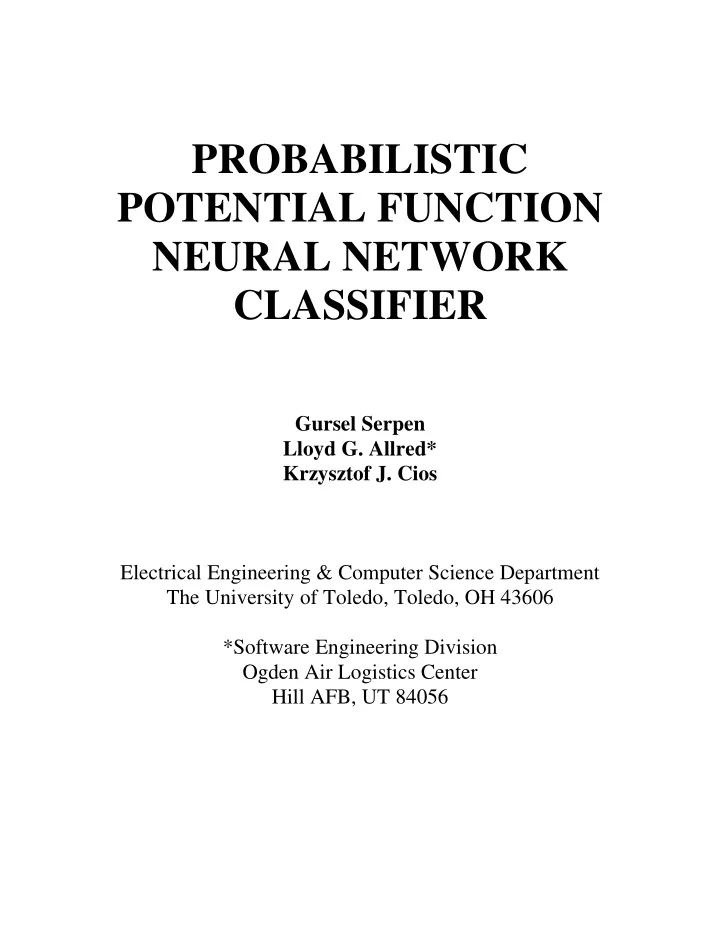

� PROBABILISTIC�� POTENTIAL�FUNCTION� NEURAL�NETWORK�� CLASSIFIER� � � � � � � Gursel�Serpen� Lloyd�G.�Allred* � Krzysztof�J.�Cios � � � � Electrical�Engineering�&�Computer�Science�Department� The�University�of�Toledo,�Toledo,�OH�43606� � *Software�Engineering�Division�� Ogden�Air�Logistics�Center� Hill�AFB,�UT�84056�
Desired�Properties�of�Proposed� Classifier� � � � ♦ � Real-time�training�and�classification� � � ♦ � Multi-modally�distributed�classes� � � ♦ � Classes� formed� from� a� set� of� disconnected� subclasses�� � � ♦ � No�initial�guess�for�the�network�topology� � � ♦ � Discover�clustering�properties�of�training�data�� � � ♦ � Adapt�to�a�minimal�network�topology� � ♦ � Implement�incremental�learning�procedure� � � ♦ � Form� optimal� decision� boundaries� -� a� theoretical�Bayesian�classifier.� �
Significant�Neural�Classification� Paradigms� � � ♦ � The�Multi-Layer�Feedforward�Network� Initial�network�topology�-�needs�guessing� slow� training� speed� -� unsuitable� for� real-time� implementations.� � � ♦ � The�Radial�Basis�Function�Network� Initialization�of�network�-�clustering�properties�of� training�data�( k -means)� Hidden�layer�node�count� � � ♦ � The�Probabilistic�Neural�Network� A� pattern� layer� node� for� each� training� pattern� Potentially�large�node�counts� � � ♦ � Learning�Vector�Quantization�Networks� Codebook�vector�initialization�-�no�well-defined� procedure�exists� �
Topology�of�PPFNN.� � � � � � �� � � w ij � � O� U� I� � T� N� P� P� �� U� U� T� T� � S� S� � Output� Layer� � MAXNET� Pattern� Layer� Layer� � Hidden� Layer� � �
� � � 2-CLASS� PROBLEM � NETWORK�CREATION�� � � � PROCESS �
� Classification�rate�in�% 100 80 60 40 20 0 LVQ LVQ MLP MLP PPFN PPFN N N Classification� algorithms � 2-Spiral�Data� � � � � � � � Classification�rate�in�% 100 90 80 70 60 50 40 30 20 10 0 LVQ LVQ RBF RBF MLP MLP PPFNN PPFNN Classification�algorithms I ris�Test�Data� � � � �
Classification�rate�in�% 80 70 60 50 40 30 20 10 0 LVQ LVQ RBF RBF MLP MLP PNN PNN PPFNN PPFNN Classification�algorithms ��������������� � � S onar�Test�Data� � � � � � Classification�rate�in�% 60 50 40 30 20 10 0 LVQ LVQ RBF RBF MLP MLP PPFNN PPFNN Classification�algorithms ������������������������������ � � ����������������������������� Vowel�Test�Data�
CONCLUSIONS� � � � Performance�of�Proposed�Algorithm� � � � Initial�findings�are�very�promising� � � Benchmark�Problems�tested�include�2-Spiral,� IRIS,�Vowel,�and�Sonar� � � Simulation�Results� � � � Fast�training�and�classification� � � High�classification�rate�on�problems�tested� � � Minimal�network�size� � � Small�number�of�empirically�determined� parameters� � � Room�to�improve�performance�
� CURRENT�WORK� � � � � � More�benchmark�problems� � � � � Determine�a�way�to�define�optimal�values�for� � potential�function�spread� � � � � Determine�an�optimal�sequence�for�weight� � values� � � � � Improve�classification�performance�-�optimality� � � �
Recommend
More recommend